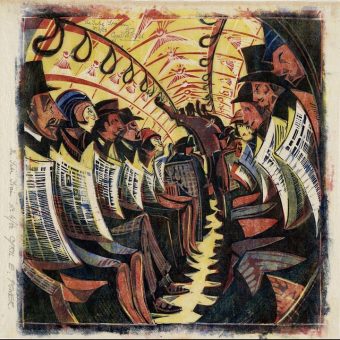“Art, since its inception has never depended upon realism. Why, one cannot help wondering, should it begin now?
– Charles Green Shaw

This great little book created by Charles Green Shaw (May 1, 1892 – April 2, 1974) in the late 1920s or early 1930s (given the styling, it’s a best guess) features black and white illustrations and poetic recipes for various cocktails. One imagines it lying on a bookshelf in Edith Wharton’s Age of Innocence (1920) or being read by PG Wodehouse’s Bertie Wooster, a lively drinker who in the novel Carry on Jeeves (1927) declared his love of cocktails thus:
“A planter, apparently, does not consider he has had a drink unless it contains at least seven ingredients, and I’m not saying, mind you, that he isn’t right. The man behind the bar told us the things were called Green Swizzles; and, if ever I marry and have a son, Green Swizzle Wooster is the name that will go down on the register.” *
What Shaw preferred to drink we don’t know. But we can say that he was a leading figure in early American abstraction and a founding member of the American Abstract Artists group (AAA), established in 1936 in New York City to champion the understanding of abstract art. Members included Josef Albers, Willem de Kooning Lee Krasner, Jackson Pollock and David Smith.
Henry Adams, Professor of Art History, Case Western Reserve University, described Shaw thus:
Indeed, few American painters of the 1930s and 1940s left an oeuvre which is so varied and consistently original. The distinction that should be made … is that Shaw was not a framer of epics but a lyric poet. His paintings have something of the quality of Japanese haiku, by a poet such as Basho, which capture the metaphysical thrill of an ecstatic moment, with a clarity, a brevity, that is breathtaking. In this particular mode, Charles Green Shaw has no serious rival.

Shaw, scion of a well to do New York family, graduated from Yale in 1914 and studied architecture at Columbia. In the 1920s he worked in journalism, writing for The New Yorker, Vanity Fair and The Smart Set. Then in 1927, he began drawing, taking classes at the Art Students League with Thomas Hart Benton and Georges Luks of the Ash Can School.
In the 1920s and 1930s he lived in Paris and London. In Europe he hung out with fellow abstractionists, such as Jean Hélion, Joan Miró, Le Corbusier in Paris, Georges Braque, Constantin Brancusi, Wolfgang Paalen, Man Ray, Ben Nicholson, Barbara Hepworth and John Ferren. He returned to New York City in 1933, and took up photography, and together with George L. K. Morris, Suzy Frelinghuysen, and Albert Eugene Gallatin became one of the ‘Park Avenue Cubists’.
Shaw was the only American artist to have two solo exhibitions at Guggenheim Museum in his lifetime. In total, he had thirty one-man shows in galleries, museums and traveling exhibitions in America, Europe, and Japan.
He died in New York City. and bequeathed fifty boxes of archival materials to the Smithsonian’s American Art Museum.


As the Weisntein Gallery notes, Shaw’s work is a composite blend of modernism, Cubism, Surrealism and Non-Objectivity. “He took these influences and forged a personalized path with the use of subtle textural variations, experiments in shapes, fine elegant lines of delicate precision, and defined colors gently overlapping or hovering in space. He could express whimsy and lyricism with the shapes in his canvases, utilizing different composites and textures, leading to biomorphic wood reliefs with birdlike forms in flight. Forms alternate from the nearly recognizable to abstracted essence. In a 1938 AAA show he also contributed an essay, “A Word to the Objector,” to the accompanying book, writing:
For honest painting, regardless of its representational or non-representational merits, embraces certain patent fundamentals. One seeks, for example, rhythm, composition, spatial organization, design, progression of color, and many, many other qualities in any aesthetic work.”






















































Would you like to support Flashbak?
Please consider making a donation to our site. We don't want to rely on ads to bring you the best of visual culture. You can also support us by signing up to our Mailing List. And you can also follow us on Facebook, Instagram and Twitter. For great art and culture delivered to your door, visit our shop.









